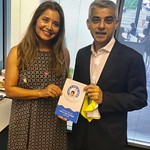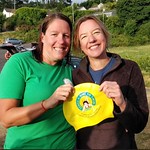
 The ‘South London Allsorts’ cross the Channel!
The ‘South London Allsorts’ cross the Channel!November 12th, 2020
By Dr Tauni Lanier How an all-women swimming crew faced the ‘villains and heroes’ of the English Channel, in the middle of the COVID-19 pandemic, for the crossing of a lifetime. “Take a seasickness pill, before we leave,” they said. Not I, I was raised on an island and was as comfortable on a boat […]
 WHAT TAGS MEANS TO ME
WHAT TAGS MEANS TO MEJuly 8th, 2019
By Sheherazade Amin The “Teach A Girl how to Swim” campaign is one that I deeply relate to and thus am thrilled to be an advocate for. As a brown girl, who moved from London to Lahore in her childhood, this campaign highlights the idea of freedom in an otherwise relatively conservative society. I learnt […]
 India´s hidden swim gem: revolutionary origins & community service
India´s hidden swim gem: revolutionary origins & community serviceMay 1st, 2018
In March 2018, the TAGS team and film crew were hosted by the country’s oldest indigenous swimming association, the National Swimming Association (NSA), a little-known swimming gem in Kolkata, to learn about its history and activities, and to discuss the TAGS campaign with staff and students. The Art Deco headquarters of the National Swimming Association […]

Cox’s Bazar beach in Bangladesh is the longest natural sandy beach in the world. It’s more than 120km long! And the ONLY lifeguarding service provided along its stretch is the SEASAFE project, provided by TAGS partners, CIPRB and RNLI.

Chairman Mao was a keen swimmer. On 16 July 1966 in his early-70s, he swam in China’s Yangtze river to show he was still in robust physical health. The event is still commemorated in China by swimming enthusiasts.

The Calcutta Swimming Club, founded in 1898, is the oldest swimming club in Asia – and possibly the world. TAGS Malini Mehra swam the first-ever 10km swim in its pool on 25 March 2018.

American Diane Nyad (64) is the first person to swim the dangerous Cuba to Florida strait without a shark cage. Nyad completed the 110-mile long swim from Havana to Key West in 53 hours in 2013 on her 5th attempt.

Swimming first became an Olympic event in 1896. At first, it was only open to men. Women had to wait another 16 years to be allowed to participate in 1912. The photo shows the gold medal-winning UK women’s swimming team at the 1912 Stockholm Olympics.

India’s Madhavi Latha is a 45-year old Paralympic swimming champ who set up the Yes We Too Can Do trust to encourage people with disabilities to take up sports.

There are no required courses at Williams College (USA), except physical education. And the ONLY skill required for graduation is the ability to swim!
https://athletics.williams.edu/physical-education/requirements-swim-test/

An Olympic size pool depending on its size (50 meters X 25 yards or meters) – like this one in Dhaka, Bangladesh – can hold from 700,000 to 850,000 gallons of water.

The oldest form of stroke used is the breaststroke. It is found in drawings of people swimming from Ancient Egypt dating back to 2500 BC. It is also the slowest stroke in the Olympics.

Swimming is the best all-round exercise. It works all the body’s major muscles, strengthens heart and lungs, reduces stress and burns up more calories than walking or biking. And you can do it at any age!

Elephants can swim up to 20 miles a day using their trunks to breathe through. This group of Elephant mermaids is swimming in the Andaman & Nicobar islands.

The legendary women free divers of Jeju island in South Korea are called haenyeo. For centuries, the haenyeo have worked in the sea diving for creatures & treasures to sell in the markets. At their height, there were 23,000 haenyeo women on Jeju. The tradition is dying out, but many active haenyo can still be found in their 70’s and 80’s on Jeju.

Swimmers have worn all sorts of protective eye goggles over the years. In 14th century Persia, pearl divers used to make them from tortoise shells. The first modern rubber goggles were made in the 1930’s in the USA.

The first woman to cross the English Channel (21 miles) was also the fastest person ever. In 1926, the American swimming prodigy, Gertrude Ederle crossed the Channel in 14 hours and 31 mins. She beat the best men’s time and became only the sixth person – and first woman – to swim the Channel. She was only 19. She was also the first to swim using the new front crawl stroke (aka freestyle) and wearing a full face mask (improvised motorbike goggles sealed with paraffin wax).

Ironically, the Bikini got its name from Bikini Atoll – the atoll in the Marshall Islands in the south Pacific, which the US govt used as a nuclear testing site for 23 explosions in the 1940s.

 TAGS founder video message for Bangladesh pool launch
TAGS founder video message for Bangladesh pool launch TAGS partners with English National Opera (ENO).
TAGS partners with English National Opera (ENO). Malini on Pakistani TV on India & climate change.
Malini on Pakistani TV on India & climate change. TAGS campaign reaches ANTARCTICA!
TAGS campaign reaches ANTARCTICA! Malini interviewed on TAGS by Thailand’s most famous broadcaster. July 2018
Malini interviewed on TAGS by Thailand’s most famous broadcaster. July 2018 BBC World features TAGS campaign
BBC World features TAGS campaignWhy in cases of climatic disasters "80% of the victims are women"
 Malini Mehra interviewed on Chinese TV (June 2018)
Malini Mehra interviewed on Chinese TV (June 2018) Malini Interview: Deutsche Welle radio on Silent Killer of Drowning
Malini Interview: Deutsche Welle radio on Silent Killer of DrowningDrowning is the world's third largest leading cause of preventable death in children — after malnutrition and diarrhea. Malini Mehra has set out to change that. The Indian civil society activist in climate change and an adviser to the head of the UN office of Disaster Risk Reduction founded the "Teach a Girl to Swim" campaign last year.
 Teaching Girls to Swim would Prevent Climate Deaths – India Climate Dialogue
Teaching Girls to Swim would Prevent Climate Deaths – India Climate DialogueA global campaign to teach young girls to swim aims to save them from death by drowning during extreme weather events such as flooding that are worsened by climate change...
 TEACH A GIRL TO SWIM – ENDURANCE WOMEN
TEACH A GIRL TO SWIM – ENDURANCE WOMENMum of three children (ages nine, 11, 13), Malini Mehra, 50 is determined to make 2018 a year that counts. She’s set herself a goal of swimming 500K...

SUPPORTING THE GLOBAL GOALS FOR SUSTAINABLE DEVELOPMENT The TAGS campaign seeks to actively support and promote implementation of the Sustainable Development Goals (SDGs), in particular Goal 3 on health and well-being, Goal 5 on gender equality, and Goal 13 on climate change. These universal goals were adopted by 196 countries at the United Nations General […]
read more































































